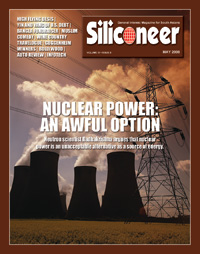EDITORIAL:
Going Nuclear
 The Indo-U.S. nuclear deal, much ballyhooed as a harbinger of a new era of closer Indo-U.S. ties, has actually turned out to be a tough political nut to crack. While a substantial segment of the Indian political establishment smarts at what it sees as unseemly U.S. encroachment of its sovereignty, a part of the U.S. foreign policy establishment has expressed qualms about throwing out of the window any semblance of nuclear nonproliferation restrictions in the case of India, worrying that it would deeply undermine global non proliferation efforts. The Indo-U.S. nuclear deal, much ballyhooed as a harbinger of a new era of closer Indo-U.S. ties, has actually turned out to be a tough political nut to crack. While a substantial segment of the Indian political establishment smarts at what it sees as unseemly U.S. encroachment of its sovereignty, a part of the U.S. foreign policy establishment has expressed qualms about throwing out of the window any semblance of nuclear nonproliferation restrictions in the case of India, worrying that it would deeply undermine global non proliferation efforts.
The whole debate, though, obscures a more fundamental question. How sound, in terms of public policy choice, is the nuclear energy option?
A veteran neutron scientist addresses this very fundamental issue in this month’s cover story. Radhakrishna, who was trained in the Radium Institute of Paris, bluntly asks: Does the solution to accelerating global warming and power shortages lie in a vast expansion of nuclear power plants connected to nationwide electrical grids?
He says there are three classical risks associated with the nuclear option: the link between the nuclear fuel cycle and the proliferation of nuclear weapons, the possibility of nuclear accidents and the problems of the disposal of the nuclear waste.
These dangers wholly offset the possible benefits provide by nuclear energy in mitigating the harsh effects of a global energy shortage.
What on earth is happening in the global economy? The rot has begun in the U.S., with house foreclosures hitting the roof, house prices tanking, and big banking giants going belly up (unless bailed out by Uncle Sam with a great risk of taxpayers picking up the tab). Now the bad loans in the U.S. housing industry have infected the global financial system through abstruse financial instruments.
For years and years the U.S. political establishment has chosen to ignore the country’s continuing trade deficit and it appears that at last the chickens may be coming home to roost. The dollar is headed south, and oil prices are not only going up, but will likely stay up.
If the U.S. continues to live on borrowed money, it automatically follows that somebody will have to cough up that money. Until now it has been foreign investors and foreign central banks that have come up with the moolah.
Now there’s a new wrinkle. As the U.S. continues to build up its debt, other nations have built up a sea of foreign exchange reserves, and some have set up sovereign funds — investment houses set up by states with huge foreign exchange reserves. Foremost among them is China.
This is sending tremors not only through the U.S. policy making establishment, but also triggering fears with a distinct xenophobic tinge in the broader community. What if sovereign funds are run or manipulated for strategic national interest rather than financial interest?
Now the truth is, there is yet no discernable sign that China has any intention of using its sovereign fund for any other purpose than pursuing financial gain, but that hasn’t quashed all doubts.
The good news, write economists Ashok Bardhan and Dwight Jaffee, is that “while foreign investors might be tempted to transfer to non-dollar denominated assets leading to dollar depreciation, inflation and related dislocations, there are slim chances of abrupt change on the part of anyone.”
The Guggenheim fellowships are one of the most prestigious awards given to artists and scholars in the U.S. This year the Guggenheim Foundation has awarded 190 fellowships to artists, scientists, and scholars, with awards totaling $8,200,000. The successful candidates were chosen from a group of more than 2,600 applicants.
Among them are five fellows of Indian descent with a distinguished track record in fields as diverse as poetry, mathematics, fiction, history and political science.
They are: Meena Alexander, poet and distinguished professor of English, Hunter College and CUNY Graduate Center (poetry); Tony D’Souza, writer, Sarasota, Florida (fiction); Sumit Guha, professor of history, Rutgers University:; Chandrashekhar B. Khare, professor of mathematics, University of California, Los Angeles; and Ashutosh Varshney, professor of political science, University of Michigan.
Pulitzer Prize winner novelist Jhumpa Lahiri; mathematicians Manil Suri and Santosh Srinivas Vempala; curator Meenakshi Wadhwa and historian Sumathi Ramaswamy, are among the previous Indian American recipients of this award.
Musician Pandit Pran Nath is said to be one of the earliest Indian-American recipient of Guggenheim fellowship, way back in 1974.
Since its establishment in 1925 the foundation has granted more than $265 million in fellowships to almost 16,500 individuals. Scores of Nobel, Pulitzer, and other prize winners grace the roll of fellows, including Ansel Adams, W. H. Auden, Aaron Copland, Martha Graham, Langston Hughes, Henry Kissinger, Vladimir Nabokov, Isamu Noguchi, Linus Pauling, Philip Roth, Paul Samuelson, Wendy Wasserstein, Derek Walcott, James Watson, and Eudora Welty.
|